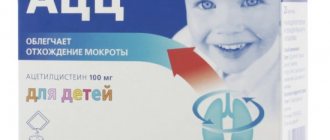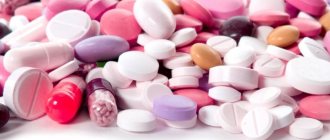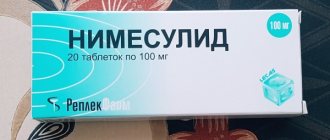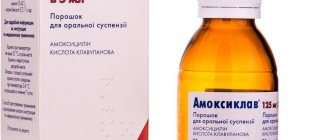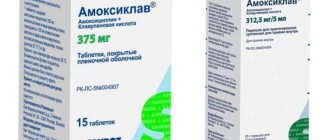Release form and composition
The dosage form of Aspirin-S is effervescent tablets: white, round, flat, beveled to the edge, with a cross-shaped imprint on one side (there are 5 laminated paper strips of 2 tablets in a cardboard pack).
Active ingredients in 1 tablet:
- acetylsalicylic acid – 400 mg;
- vitamin C (ascorbic acid) – 240 mg.
Auxiliary components: sodium carbonate – 200 mg, sodium citrate – 1206 mg, citric acid – 240 mg, sodium bicarbonate – 914 mg.
Similar means
ASA has several medicinal properties, which has allowed it to become a universal, easy-to-use remedy. There are many substitutes for effervescent Aspirin:
- Aspirin Cardio is an antithrombotic drug based on ASA (100 mg per tablet). It is used as a preventive therapy for blood clots and embolisms, as well as during the recovery period after myocardial infarction and coronary artery disease. Rarely causes adverse reactions, since the concentration of salicylates is quite low.
Citramon is a combination drug that consists of acetylsalicylic acid, paracetamol and caffeine. Available in the form of white tablets, it is used as a pain reliever. It is used more often than other medications for mild headaches. Thanks to the caffeine in the composition, it has a stimulating effect on the nervous system and helps fight drowsiness.- Acecardol - tablets contain 50, 100 and 300 mg of ASA. Prescribed for the prevention of blood clots, myocardial infarction, stroke and coronary artery disease. The drug is most often taken by patients with excess weight, bad habits, and people in the older age category, as they belong to a risk group for the development of cardiovascular diseases and the formation of blood clots.
Pharmacological properties
Pharmacodynamics
Aspirin-S is one of the combined non-steroidal anti-inflammatory drugs. Its action is determined by the properties of the active components:
- acetylsalicylic acid: has anti-inflammatory, antipyretic, analgesic properties, which is associated with the suppression of COX-1 and -2 (cyclooxygenase-1 and -2), which regulate the synthesis of prostaglandins; acetylsalicylic acid also inhibits platelet aggregation;
- ascorbic acid: a vitamin that helps increase the body's resistance and is necessary for the regulation of many processes, including tissue regeneration, carbohydrate metabolism, redox processes, blood clotting.
Pharmacokinetics
Acetylsalicylic acid
After oral administration, it is quickly and completely absorbed from the gastrointestinal tract. During/after absorption, salicylic acid is formed, the main active metabolite. The maximum plasma concentration of acetylsalicylic acid in the blood is achieved in 10–20 minutes, of salicylates in 20–120 minutes.
The binding of acetylsalicylic and salicylic acids to blood plasma proteins is complete, they are quickly distributed in the body. Salicylic acid crosses the placenta and into breast milk.
The metabolism of salicylic acid occurs primarily in the liver. Its main metabolites are gentisin uric acid, salicylic uric acid, salicylacyl glucuronide, salicylphenol glucuronide, gentisic acid.
The metabolism of salicylic acid is limited by the activity of liver enzymes, so the excretion kinetics are dose-dependent. The half-life also depends on the dose: with low doses it is 2-3 hours, with high doses it is approximately 15 hours. Salicylic acid and its metabolites are excreted primarily by the kidneys.
Ascorbic acid
After oral administration, absorption occurs in the intestine using a Na+-dependent active transport system, the most active process is observed in the proximal intestine.
Absorption of ascorbic acid is disproportionate to the dosage. With an increase in the daily dose, its plasma concentration in the blood and other body fluids does not increase proportionally, but tends to the upper limit.
Ascorbic acid is filtered through the glomeruli and reabsorbed under the influence of a Na+-dependent process by the proximal tubules. Excretion of the main metabolites in the form of diketogulonic acid and oxalates occurs in the urine.
general information
All varieties of effervescent aspirin have an anti-inflammatory effect, reduce body temperature and produce an analgesic effect due to the content of acetylsalicylic acid in the composition. The water-soluble form of the drug significantly reduces the risk of developing unwanted side reactions from the gastrointestinal tract.
Properties of aspirin
These drugs belong to the group of non-steroidal anti-inflammatory drugs and have one INN - Acetylsalicylic acid. The drugs are used not only for mild dental pain and headaches, but also for neuralgia, myalgia, premenstrual and withdrawal syndromes, and fever. And also as one of the components of complex therapy for increased risks of coronary heart disease, angina pectoris and myocardial infarction.
Forms of release and prices for drugs, average in Russia
Release form: white water-soluble tablets for preparing a solution. When the tablet is dissolved in water, gas bubbles begin to release.
| Drug name | Distinctive features | price, rub. |
| Aspirin C | Contains Vitamin C (240mg) ASA concentration reduced to 400 mg/tab Helps with hangover. Manufacturer – Bayer (Germany) | 234 |
| Aspirin Oops | Manufacturer – France. Contains 1 active component – ASA (500 mg) | 194 |
| Aspirin Express | The list of auxiliary components has been reduced to corn starch and microcrystalline cellulose. | 274 |
All three drugs have the same mechanism of action, general indications and contraindications for use. Since any type of Aspirin contains ASA, the list of adverse reactions and symptoms of overdose are absolutely identical.
Composition, pharmacodynamics and pharmacokinetics
Effervescent aspirin mainly contains 1 main component - Acetylsalicylic acid (500 mg). But Aspirin C also contains ascorbic acid. Excipients are: anhydrous citric acid, anhydrous sodium hydrocarbonate and sodium citrate, K-30, aspartame, crospovidone.
Mechanism of action
The pharmacological action of the drugs is based on inhibition of the enzyme cyclooxyginase by the active substance, thereby blocking the synthesis of prostaglandins. They are the ones involved in the chemical processes that transmit signals to the brain that are recognized as pain. The drug also affects thermoregulation centers and inhibits the formation of ATP, thereby achieving an antipyretic and anti-inflammatory effect.
A solution of effervescent tablets is absorbed much faster than regular Aspirin. The maximum concentration of ASA in the body can be observed within 15 minutes after taking the drug. Salicylic acid is quickly and evenly distributed throughout all tissues and fluids of the body. Therefore, the drug is able to penetrate the placental barrier and enter breast milk. It disintegrates in the liver and is excreted primarily in the urine in the form of metabolic products.
Contraindications
Absolute:
- gastrointestinal bleeding, a period of exacerbation of erosive and ulcerative lesions of the gastrointestinal tract;
- combination therapy with methotrexate at a dose of 15 mg per week;
- asthma associated with therapy with salicylates or other non-steroidal anti-inflammatory drugs, in combination with nasal polyps;
- severe impairment of hepatic/renal function;
- hemophilia;
- thrombocytopenia;
- deficiency of glucose-6-phosphate dehydrogenase;
- hemorrhagic diathesis;
- I and III trimesters of pregnancy and breastfeeding;
- age up to 15 years;
- individual intolerance to the components of the drug and other non-steroidal anti-inflammatory drugs.
Relative (Aspirin-S is prescribed under medical supervision):
- tendency to gastrointestinal bleeding;
- anemia;
- hypovitaminosis K;
- thyrotoxicosis;
- conditions in which the development of fluid retention in the body is possible, including cardiac dysfunction, arterial hypertension;
- gout;
- concomitant therapy with anticoagulants;
- erosive gastritis;
- aggravated medical history of gastric and/or duodenal ulcers;
- hypoprothrombinemia;
- II trimester of pregnancy.
Indications and contraindications
What does effervescent Aspirin help with? The drug has an extensive list of indications and is prescribed not only for a single dose, but also as a component of complex therapy for the long-term treatment of cardiovascular diseases. Thanks to the combined effect of ASA and ascorbic acid, Aspirin C has a therapeutic effect on hangovers and prevents the onset of withdrawal syndrome.
Most often the drug is prescribed for the following conditions:
- For mild pain syndrome of various etiologies (recurrent pain in women, headache, pain in muscles and joints).
Neuralgia and myalgia.- Withdrawal syndrome.
- Arthritis.
- Moderate back pain.
- The risk of coronary artery disease, myocardial infarction and angina pectoris (as complex therapy).
Contraindications for use are as follows:
- hypersensitivity to salicylates;
- phenylketonuria (due to aspartame content);
- alkalosis;
- lack of calcium;
- low acidity of gastric juice (contains alkaline components);
- bronchial asthma;
- stomach and duodenal ulcers;
- blood diseases associated with bleeding disorders;
- severe renal and heart failure.
Basically, all contraindications are based on individual intolerance to one or another component in the presence of concomitant diseases.
The drug is not approved for use by pregnant women and women who are breastfeeding, since salicylic acid has a negative effect on both the fetus and the baby.
Short-term use of the drug in the 1st and 2nd trimesters of pregnancy is possible, only if the benefit to the mother significantly outweighs the harm to the child. In the 3rd trimester, the drug is contraindicated, as it can lead to post-term pregnancy, weakening of labor and problems with the kidneys and blood in the child.
The drug is contraindicated in children under 15 years of age, as there is a risk of Reye's syndrome, a condition that poses a direct threat to the child's life.
Instructions for use of Aspirin-S: method and dosage
Aspirin-S is taken orally. The tablet must first be dissolved in 200 ml of water.
Single dose – 1 or 2 (maximum) tablets. The drug can be taken at intervals of at least four hours. The maximum daily dose is 6 tablets.
If there are no other doctor’s prescriptions, the duration of therapy is determined by the indications and is:
- no more than 7 days - Aspirin-S is taken as an analgesic;
- no more than 3 days - Aspirin-S is taken as an antipyretic.
Side effects
- central nervous system: tinnitus, dizziness (as a rule, these disorders indicate an overdose);
- digestive system: vomiting, nausea, abdominal pain, obvious (bloody vomiting, black stools) or hidden symptoms of gastrointestinal bleeding (can cause iron deficiency anemia), erosive and ulcerative lesions of the gastrointestinal tract (including perforation); rarely - impaired liver function (in the form of increased liver transaminases);
- urinary system: with high-dose therapy – damage to the glomerular apparatus of the kidneys, formation of urinary stones from calcium oxalate and hyperoxaluria;
- hematopoietic system: thrombocytopenia, hemorrhagic syndrome;
- allergic reactions: bronchospasm, Quincke's edema, anaphylactic reactions, skin rash.
Overdose
Main symptoms:
- initial stage: increased breathing, stimulation of the central nervous system, vomiting, nausea, severe headache, dizziness, decreased hearing acuity, blurred vision;
- late symptoms: disturbances of water and electrolyte metabolism, respiratory failure, drowsiness, anuria, convulsions, depression of consciousness up to coma.
Therapy: induce vomiting/do gastric lavage, prescribe activated charcoal and drugs with laxative effects. Treatment should be carried out in specialized departments.
special instructions
Due to the risk of Reye's syndrome (manifested in the form of encephalopathy and acute fatty liver with the rapid development of liver failure), Aspirin-S effervescent tablets are not prescribed to children under 15 years of age as an antipyretic for acute respiratory diseases caused by viral infections.
The effect of acetylsalicylic acid is associated with a decrease in the excretion of uric acid from the body. If there is a predisposition, this can lead to the development of an acute attack of gout.
In cases of a long-term therapeutic course, it is recommended to periodically monitor the functional state of the liver, do a stool test for occult blood and a general blood test.
Acetylsalicylic acid slows down blood clotting. Before undergoing surgery, you should inform your doctor about taking Aspirin-S.
Due to the likelihood of an increased risk of gastrointestinal bleeding, drinking alcohol is contraindicated during therapy.
One dose of Aspirin-S contains 933 mg of sodium, which should be taken into account by patients on a salt-free diet.
Aspirin Express tab/fizzy drink 500mg No. 12 98380
Description
Aspirin® Express effervescent tablets 500 mg; strip 2, cardboard pack 6; No. P N016188/01, 2009-12-10 from Bayer ZAO (Russia); manufacturer: Bayer Bitterfeld GmbH (Germany) Latin name Aspirin® Express Active ingredient Acetylsalicylic acid (Acidum acetylsalicylicum) ATC: N02BA01 Acetylsalicylic acid Pharmacological group NSAIDs - Salicylic acid derivatives Indications for IHD, the presence of several risk factors for IHD, silent myocardial ischemia, unstable angina , heart attack myocardial infarction (to reduce the risk of recurrent myocardial infarction and death after myocardial infarction), recurrent transient cerebral ischemia and ischemic stroke in men, heart valve replacement (prevention and treatment of thromboembolism), balloon coronary angioplasty and stent placement (reducing the risk of recurrent stenosis and treatment of secondary dissection coronary artery), as well as for non-atherosclerotic lesions of the coronary arteries (Kawasaki disease), aortoarteritis (Takayasu disease), valvular mitral heart defects and atrial fibrillation, mitral valve prolapse (thromboembolism prevention), recurrent pulmonary embolism, Dressler syndrome, pulmonary infarction, acute thrombophlebitis. Fever in infectious and inflammatory diseases. Pain syndrome of weak and medium intensity of various origins, incl. thoracic radicular syndrome, lumbago, migraine, headache, neuralgia, toothache, myalgia, arthralgia, algodismenorrhea. In clinical immunology and allergology, it is used in gradually increasing doses for long-term “aspirin” desensitization and the formation of stable tolerance to NSAIDs in patients with the “aspirin” triad. According to indications: rheumatism, rheumatic chorea, rheumatoid arthritis, infectious-allergic myocarditis, pericarditis - currently used very rarely. Contraindications Hypersensitivity, incl. “aspirin” triad, “aspirin” asthma; hemorrhagic diathesis (hemophilia, von Willebrand disease, telangiectasia), dissecting aortic aneurysm, heart failure, acute and recurrent erosive and ulcerative diseases of the gastrointestinal tract, gastrointestinal bleeding, acute renal or liver failure, initial hypoprothrombinemia, vitamin K deficiency, thrombocytopenia, thrombotic thrombocytopenic purpura , deficiency of glucose-6-phosphate dehydrogenase, pregnancy (I and III trimester), breastfeeding, childhood and adolescence up to 15 years when used as an antipyretic (risk of developing Reye's syndrome in children with fever due to viral diseases). Use during pregnancy and lactation The use of large doses of salicylates in the first trimester of pregnancy is associated with an increased incidence of fetal development defects (cleft palate, heart defects). In the second trimester of pregnancy, salicylates can be prescribed only after assessing the risks and benefits. The administration of salicylates in the third trimester of pregnancy is contraindicated. Salicylates and their metabolites pass into breast milk in small quantities. Accidental intake of salicylates during lactation is not accompanied by the development of adverse reactions in the child and does not require cessation of breastfeeding. However, with long-term use or high doses, breastfeeding should be discontinued. Side effects From the cardiovascular system and blood (hematopoiesis, hemostasis): thrombocytopenia, anemia, leukopenia. From the gastrointestinal tract: NSAID gastropathy (dyspepsia, pain in the epigastric region, heartburn, nausea and vomiting, severe bleeding in the gastrointestinal tract), loss of appetite. Allergic reactions: hypersensitivity reactions (bronchospasm, laryngeal edema and urticaria), formation of the “aspirin” bronchial astriad based on the hapten mechanism (eosinophilic rhinitis, recurrent nasal polyposis, hyperplastic sinusitis). Other: impaired liver and/or kidney function, Reye's syndrome in children (encephalopathy and acute fatty liver with rapid development of liver failure). With long-term use - dizziness, headache, tinnitus, decreased hearing acuity, blurred vision, interstitial nephritis, prerenal azotemia with increased blood creatinine levels and hypercalcemia, papillary necrosis, acute renal failure, nephrotic syndrome, blood diseases, aseptic meningitis, increased symptoms of congestive heart failure, edema, increased levels of aminotransferases in the blood. Precautions Concomitant use with other NSAIDs and glucocorticoids is undesirable. 5–7 days before surgery, it is necessary to stop taking the drug (to reduce bleeding during surgery and in the postoperative period). The likelihood of developing NSAID gastropathy is reduced when prescribed after meals, using tablets with buffer additives or coated with a special enteric coating. The risk of hemorrhagic complications is considered to be lowest when used in daily doses. It should be borne in mind that in predisposed patients, acetylsalicylic acid (even in small doses) reduces the excretion of uric acid from the body and can cause the development of an acute attack of gout. During long-term therapy, it is recommended to regularly perform blood tests and examine stool for occult blood. Due to observed cases of hepatogenic encephalopathy, it is not recommended for the relief of febrile syndrome in children. Storage conditions for Aspirin® Express: At a temperature not exceeding 25 °C. Keep out of the reach of children. The shelf life of Aspirin® Express is 3 years. Do not use after the expiration date stated on the package. 2000-2015. Register of Medicines of Russia The database is intended for healthcare professionals. Commercial use of materials is not permitted.
Possible product names
- Aspirin Express tab/fizzy drink 500mg No. 12
- ASPIRIN EXPRESS 500 MG TAB. THORN. No. 12
- ASPIRIN EXPRESS 0.5 N12 SHIP TABLE
- ASPIRIN EXPRESS TABLE SPIKE. 500 MG X12
- ASPIRIN EXPRESS TAB. THORN. 500MG No. 12
- ASPIRIN EXPRESS 500MG TAB. EFFERVANT X12
- (Aspirin Express) Aspirin Express tab/fizzy drink 500mg No. 12
Drug interactions
Possible interactions:
- glucocorticosteroids, ethanol-containing drugs and ethanol: the damaging effect on the mucous membrane of the gastrointestinal tract of Aspirin-S and the likelihood of developing gastrointestinal bleeding increases;
- opioid analgesics, heparin, other non-steroidal anti-inflammatory drugs, thrombolytics and platelet aggregation inhibitors, oral hypoglycemic agents, indirect anticoagulants, sulfonamides (including co-trimoxazole), reserpine, triiodothyronine: their effects are enhanced;
- methotrexate: its toxicity increases;
- uricosuric drugs (sulfinpyrazone, benzbromarone), antihypertensives and diuretics (furosemide, spironolactone): their effectiveness is reduced;
- antacids containing magnesium/aluminum hydroxide: absorption of acetylsalicylic acid worsens and slows down;
- digoxin, barbiturates and lithium preparations: their plasma concentration increases;
- Iron preparations: their absorption in the intestines improves (due to ascorbic acid).
Aspirin Complex, 10 pcs., effervescent powder for the preparation of solution for oral administration
Acetylsalicylic acid Combination with Methotrexate at a dose of > 15 mg per week is contraindicated. Combinations of drugs that are used with caution: Methotrexate at a dose of less than 15 mg/week: With simultaneous use of drugs, the hematological toxicity of methotrexate increases due to the fact that NSAIDs in general reduce the renal clearance of methotrexate, and salicylags, in particular, displace it from association with plasma proteins . Anticoagulants (coumarin, heparin): when taking ASA and indirect anticoagulants simultaneously, the risk of bleeding increases due to suppression of platelet function, damage to the mucous membrane of the stomach and duodenum and displacement of oral anticoagulants from their connection with plasma proteins. Other NSAIDs with salicylates in high doses (at a dose of 3 g/day or more): with simultaneous use of drugs due to the synergistic effect, the risk of ulcers of the gastrointestinal mucosa and bleeding increases. Uricosuric drugs (probenecid, sulfinpyrazone): the therapeutic effect of uricosuric drugs is reduced due to competitive tubular elimination of uric acid. Digoxin: with simultaneous use of drugs, the concentration of digoxin in plasma increases due to a decrease in its excretion. Antidiabetic drugs (insulin, sulfonylurea): the hypoglycemic effect is enhanced due to the fact that ASA in a high dose has hypoglycemic properties and displaces sulfonylurea from binding to plasma proteins. Thrombolytics/antiplatelet drugs of other classes (ticlopidine): increased risk of bleeding. Diuretics in combination with ASA at a dose of 3 g/day or more: glomerular filtration is reduced due to a decrease in the synthesis of prostaglandins in the kidneys. Systemic glucocorticosteroids (GCS), with the exception of hydrocortisone (used to treat Addison's disease): with simultaneous use of drugs, the concentration of salicylates in the blood decreases, since GCS enhances the elimination of salicylates. Angiotensin-converting enzyme (ACE) inhibitors: with simultaneous use of ACE inhibitors and ASA at a dose of 3 g/day or more, a decrease in the hypotensive effect of ACE inhibitors is observed due to a decrease in glomerular filtration. Valproic acid: ASA disrupts the binding of valproic acid to plasma proteins, resulting in increased toxicity. Alcohol: when combined with ASA, the damaging effect on the mucous membrane of the gastrointestinal tract increases and bleeding time prolongs. Phenylephrine Monoamine oxidase inhibitors (MAO inhibitors): with the simultaneous use of phenylephrine and MAO inhibitors (antidepressants - tranylcypromine, moclobemide; antiparkinsonian drugs - selegiline), severe side effects are possible in the form of intense headache, increased blood pressure and body temperature. Beta-blockers - with simultaneous use, an increase in blood pressure (arterial hypertension) and severe bradycardia is possible. Sympathomimetics: with simultaneous use, the effect of sympathomimetics on the central nervous system and cardiovascular system is enhanced. Possible agitation, irritability, insomnia. Inhalational anesthetics: The use of filephrine before inhalational anesthesia increases the risk of cardiac arrhythmias. Treatment with phenylephrine should be discontinued several days before elective surgery. Rauwolfia alkaloids - with simultaneous use, the therapeutic effect of phenylephrine may be reduced. Caffeine: Concomitant use may increase the therapeutic and toxic effects of caffeine. Indomethacin, bromocriptine: in isolated cases, when phenylephrine is used concomitantly with indomethacin or bromocriptine, severe arterial hypertension is possible. Selective serotonin reuptake inhibitors: when used simultaneously with antidepressants of this group (fluvoxamine, paroxetine, sertraline), both the body's sensitivity to sympathomimetics and the risk of developing a serotonergic effect may increase. Antihypertensive drugs from the sympatholytic group, such as reserpine, guanethidine: phenylephrine reduces the hypotensive effect of these drugs. Chlorphenamine Alcohol, hypnotics, tranquilizers, antipsychotics (neuroleptics), neutral analgesics: chlorphenamine may enhance the depressant effect of these drugs on the central nervous system. Anticholinergic drugs (atropine, antispasmodics, tricyclic antidepressants, MAO inhibitors, antiparkinsonian drugs): chlorphenamine enhances the anticholinergic effect of these drugs.
Reviews about Aspirin-S
According to reviews, Aspirin-S effectively relieves pain of various etiologies and symptoms of fever associated with colds and infectious diseases. The drug is often used as a hangover cure. They note its availability in pharmacies, pleasant taste, and ease of use.
There are different opinions regarding price. Many indicate that the cost is acceptable, but some consider it overpriced. The disadvantages of Aspirin-S include a large number of contraindications for use, negative effects on the gastrointestinal tract and the possibility of bleeding.
